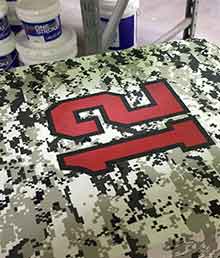Strategy October 10, 2016
Screen-Printing Myth Busters
We refute seven popular screen-printing ink myths.
Screen printers learn in seminars, through webinars and videos, from reading books and working with more experienced printers and, of course, by trial and error. There’s a lot of information available about screen-printing inks – what types to use, how they should be tested, and which work and which don’t. Here, we bust some of those myths, and show what screen-printing inks can – and can’t – do.
Myth #1
The stretch test. For years, the stretch test has been recommended to check whether a plastisol ink is cured. The test works like this: The printer pulls on the print. If it cracks, it’s under-cured. If the print doesn’t crack, then it’s sufficiently cured. This may be an excellent first test, as a cracking print will often prove to be under-cured. It isn’t, however, definitive. Even though the top layer of ink is fully cured and doesn’t crack, the bottom layer of ink on the fabric may still be under-cured. If the bottom layers are under-cured, this will be apparent as the apparel is washed and dried. Don’t rely on the stretch test to assess the whether your print is fully cured or not.
Myth #2
The infrared temperature gun. Many screen printers use an infrared temperature gun to measure the temperature of their plastisol prints. This type of measurement is thought to be extremely accurate, but the problem is that an infrared gun only measures the top layer of ink, so it can’t tell you if the print is fully cured all the way to the fabric. Plastisol ink requires time and temperature to cure; the ink deposits require time to heat through to the fabric. Since the gun only measures the top layer, the readout it gives won’t be helpful. Consider Thermolabels or a heat probe instead.
Myth #3
Sublimated polyester can’t be screen printed. Sublimated polyester garments, such as striped soccer uniforms or digital camo tees, have always been tough to screen print, as dye migration can be extreme. With the advent of low-temperature inks, like One Stroke Inks’ ELT Digital Black Underbase, sublimated garments can be screen printed without dye migration.
Myth #4
Polypropylene can’t be screen printed. It’s a good guess that almost every printer has encountered this one at some point. Most printing methods and inks require temperatures that are too high for polypropylene, so the item melts when heat is added. Because of this, plastisol ink was never an option for printing these bags, and printers were left with the option of air-dry inks. With the advent of low-temperature plastisol inks, such as the ELT series, polypropylene bags can be printed at temperatures that won’t cause them to melt.
Myth #5
A lower dryer temperature will prevent dye migration. Simply using a lower dryer temperature won’t prevent dye migration with plastisol ink. Polyester dye will turn into a gas at much lower temperatures than even low-temperature plastisol ink requires. Printers may try to cure their regular inks at slightly lower temperatures in an effort to prevent dye migration, but this rarely works. When the prints have been washed a few times, they’ll most likely bleed far worse, as slightly under-cured ink doesn’t have good bleed resistance.
Myth #6
Using a nylon catalyst to air-dry plastisol ink. A nylon catalyst is meant to give plastisol ink better adhesion to waterproof and water-resistant nylon – it isn’t meant to make a plastisol ink air-dry to any fabric. This method isn’t a durable alternative to heat-curing plastisol. For plastisol ink to be durable, it still must reach the curing temperature whether or not a nylon catalyst is added.
Myth #7
Sending polyester through the dryer before printing to stop dye migration. Sending a 100% polyester shirt through the dryer before printing won’t stop dye migration. When polyester gets hot, the dye can escape the threads by turning into a gas. If the red shirt is still red, there’s plenty of dye that can bleed. Every time the shirt is heated, dye will turn into gas and bleed into the ink. Your best bet is to print with bleed-resistant ink to prevent dye migration on polyester and poly blends.
Image courtesy of One Stroke Inks

